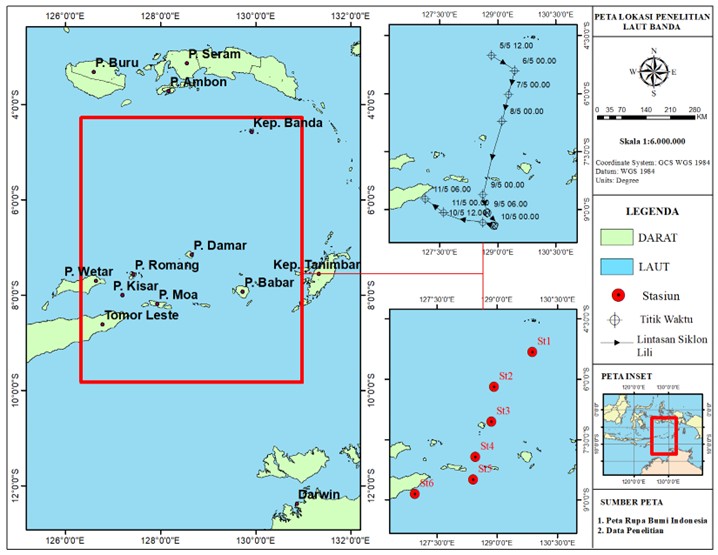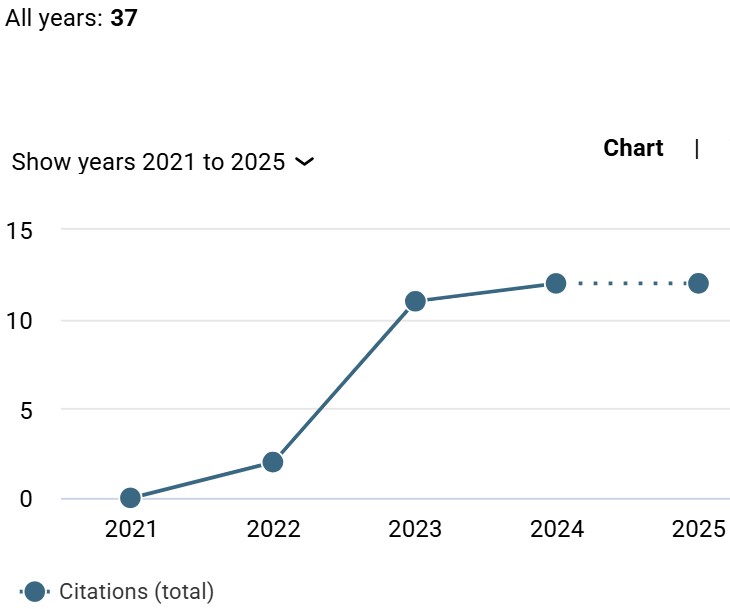Tropical cyclone Lili in the Banda Sea, Indonesia: formation, development, and oceanic interaction
Abstract
The Banda Sea serves as Indonesia's central region of water mass circulation and receives water flows from the Pacific Ocean, Indian Ocean, and South China Sea. This unique position facilitates significant interactions between the atmosphere and the ocean. This study aims to assess the dynamic factors supporting tropical cyclone Lili's growth in the Banda Sea. This study uses data from the Climate Data Store (CDS) and Marine Copernicus for May 4-12, 2019. The results show atmospheric dynamics, including the presence of low-pressure zones, high air humidity, and other meteorological factors that support the formation and movement of cyclones. During the study period, oceanographic conditions showed varying wind directions from various sources, hindering the wave formation process. Current patterns were observed moving from Australia through Tanimbar waters towards the Banda, Seram, and Timor Seas. In addition, eddy formation was found in Wetar waters, with downwelling processes occurring in the Banda Sea, while upwelling was detected in eastern Seram waters.
References
Aldrian, E. (2014). Pemahaman dinamika iklim di negara kepulauan Indonesia sebagai modalitas ketahanan bangsa. Orasi Pengukuhan Profesor Riset Bidang Meteorologi Dan Klimatologi, November, 1-73.
Asrianti, P., Bey, A., & Ilhamsyah, Y. (2013). Kajian beberapa karakteristik siklon tropis (Kasus topan Choi-Wan dan Nida di Lautan Pasifik Utara bagian Barat). Depik, 2(3), 154-161. http://dx.doi.org/10.13170/depik.2.3.974
Chang, Y. C., Tseng, R. S., Chu, P. C., Chen, J. M., & Centurioni, L. R. (2016). Observed strong currents under global tropical cyclones. Journal of Marine Systems, 159, 33-40. https://doi.org/10.1016/j.jmarsys.2016.03.001
Emanuel, K. (2003). Tropical cyclones. Annual review of earth and planetary sciences, 31(1), 75-104. https://doi.org/10.1146/annurev.earth.31.100901.141259
Fibriantika, E., & Alhaqq, R. I. (2019). Profil vertikal atmosfer selama aktifitas siklon tropis Cempaka dan Dahlia. Jurnal Meteorologi dan Geofisika, 19(2), 49-58. https://doi.org/10.31172/jmg.v19i2.589
Haryani, N. S., & Zubaidah, A. (2012). Dinamika siklon tropis di Asia Tenggara menggunakan data penginderaan jauh. Jurnal Ilmiah Widya, 29, 54-58.
Kang, J. M., & Son, S. W. (2021). Development processes of the explosive cyclones over the northwest Pacific: Potential vorticity tendency inversion. Journal of the Atmospheric Sciences, 78(6), 1913-1930. https://doi.org/10.1175/JAS-D-20-0151.1
Khotimah, M. K., Radjab, A. F., & Budiarti, M. (2009). Siklon Tropis Kirrily: Anomali di Dekat Ekuator. Buletin Meteorologi dan Geofisika.
Kurniawan, R., Habibie, M. N., & Suratno, S. (2011). Variasi bulanan gelombang laut di Indonesia. Jurnal Meteorologi dan Geofisika, 12(3), 221-232 https://doi.org/10.31172/jmg.v12i3.104
Mulyana, E., Prayoga, M. B. R., Yananto, A., Wirahma, S., Aldrian, E., Harsoyo, B., & Sunarya, Y. (2018). Tropical cyclones characteristic in southern Indonesia and the impact on extreme rainfall event. MATEC Web of Conferences (Vol. 229, p. 02007). EDP Sciences. https://doi.org/10.1051/matecconf/201822902007
Paulus, A. W., & Yusa, S. (2009). Impact Study of the Tropical Cyclone “Kirrily” to the Southeast Mollucas & West Papua Areas on 26-29 April 2009. Mod App Ocean & Pet Sci 1(5)-2018. MAOPS. MS. ID, 125. http://dx.doi.org/10.32474/MAOPS.2018.01.000125
Pucik, T., Groenemeiger, P., & Tsonevsky, I. (2021). Vertical wind shear and convective storms. European Centre for Medium-Range Weather Forecasts. http://dx.doi.org/10.21957/z0b3t5mrv
Putra, D., & Khomarudin, M. R. (2004). Depresi dan siklon tropis pengaruhi cuaca Indonesia. Berita Inderaja, 3(5), 16-20.
Prasetya, R., As'ari., & Dayantolis, W. (2014). Analisis Dampak Siklon Tropis Nangka, Parma, dan Nida pada Distribusi Curah Hujan di Sulawesi Utara. Jurnal Fisika dan Aplikasinya, 10(1), 1-9. http://dx.doi.org/10.12962/j24604682.v10i1.816
Ridwan, F., Syamsuddin, M. L., Ismail, M. R., & Sari, Q. W. (2024). Pengaruh Siklon Tropis Paddy Terhadap Kondisi Oseanografi Di Wilayah Perairan Selatan Jawa Barat. Scientica: Jurnal Ilmiah Sains dan Teknologi, 2(11), 634-653.
Sagala, E. A., & Saragih, I. J. A. (2021). Kajian Dampak Siklon Tropis Cempaka Terhadap Variabilitas Kejadian Upwelling Di Perairan Selatan Jawa. Prosiding Seminar Nasional Fisika, 1 (1), 193-200.
Stewart, R. H. (2008). Introduction to physical oceanography. Department of Oceanography, Texas A & M University, Texas USA. 344 p. https://oaktrust.library.tamu.edu/handle/1969.1/160216
Sukresno, B., & Kasa, I. W. (2008). Dynamical analysis of Banda Sea concerning with El Nino, Indonesian Through Flow and Monsoon by using satellite data and numerical model. Ecotrophic: Journal of Environmental Science, 3(2), 87-91.
Suryantoro, A. (2010). Siklon Tropis di selatan dan barat daya Indonesia dari pemantauan satelit TRMM dan kemungkinan kaitannya dengan gelombang tinggi dan puting beliung. Majalah Sains dan Teknologi Dirgantara, 3(1), 21-32.
Syaifullah, M. D. (2015). Siklon tropis, karasteristik dan pengaruhnya di wilayah Indonesia pada tahun 2012. Jurnal Sains & Teknologi Modifikasi Cuaca, 16(2), 61-71. http://dx.doi.org/10.29122/jstmc.v16i2.1048
Tubalawony, S., Kusmanto, E., & Muhadjirin, M. (2012). Suhu dan salinitas permukaan merupakan indikator upwelling sebagai respon terhadap angin muson tenggara di perairan bagian utara Laut Sawu. ILMU KELAUTAN: Indonesian Journal of Marine Sciences, 17(4), 226-239. https://doi.org/10.14710/ik.ijms.17.4.226-239
Tubalawony, S., Hukubun, R. D., & Kalay, D. E. (2024). The Seasonal Variations of the Thermocline in the Banda Sea and its Water Mass Characteristics. Jurnal Penelitian Pendidikan IPA, 10(SpecialIssue), 534-545. https://doi.org/10.29303/jppipa.v10iSpecialIssue.9071
Tubalawony, S., Wattimena, M. C., & Rahman. (2025). Characteristics and Analysis of Water Mass Structure in the Waters of the Haruku Strait, Indonesia. Egyptian Journal of Aquatic Biology & Fisheries, 29(2), 199-217. https://dx.doi.org/10.21608/ejabf.2025.416019
Yumoto, M., & Matsuura, T. (2001). Interdecadal variability of tropical cyclone activity in the western North Pacific. Journal of the Meteorological Society of Japan. Ser. II, 79(1), 23-35. https://doi.org/10.2151/jmsj.79.23
Zakir, A., & Khotimah, M. K. (2006). Badai dan pengaruhnya terhadap cuaca buruk di Indonesia. BMKG; Jakarta.

Copyright (c) 2025 Moksen Siwasiwan, Simon Tubalawony, Yunia Anganetjie Noya

This work is licensed under a Creative Commons Attribution-ShareAlike 4.0 International License.
Copyright on articles was retained by the respective author(s) without restrictions. The author grants the journal its first publication rights with the work simultaneously licensed under the Creative Commons Attribution-ShareAlike 4.0 International (CC BY-SA) license. This means anyone is free to copy, transform, or redistribute articles for any lawful purpose in any medium, provided they give appropriate attribution to the original author(s).














